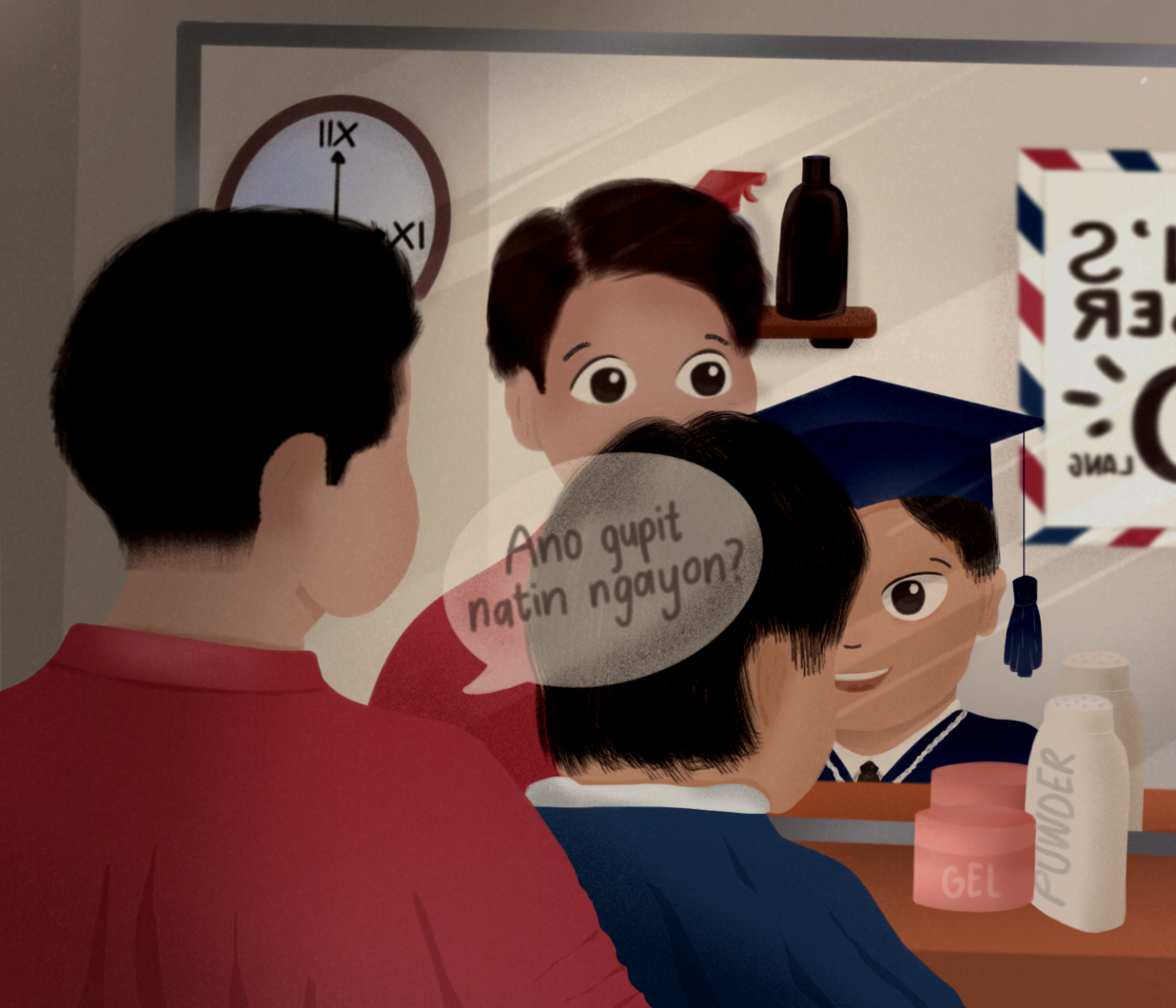With a comb in their left hand and a clipper in the other, barbers strive not only to make ends meet but also to offer their time and listening ears.
AS YOU gently push open the glass door of Sideburns Barbershop, you hear the distinct harmonization of the whirs of clippers and scissors and the murmurs of the barbers and clients.
These clients visit barbershops for various reasons: Some seek a new look, others prepare for special events, while many simply want to maintain their appearance or indulge themselves in a moment of self-care. Whatever these reasons may be, barbers consider each visit invaluable to their livelihood.
Sideburns Barbershop’s regular patrons—or suki—trust no one with their hair aside from Kuya Gilbert, Kuya AJ, Kuya Eduard, and Kuya Bernard. While all four hail from San Mateo, Rizal, each barber carries distinct experiences enriched by their respective haircutting journeys.
Noong panahon namin
Armand Jun Cortez Timbal, or Kuya AJ, discovered his talent in cutting hair at a young age while observing a local barber in his neighborhood. Having the urge to try cutting hair, he initially practiced on his classmates for free when he was in Grade 6. He shared that the process of cutting hair in their province back in the 2000s was far different from how it is now.
“Doon sa amin, mano-mano. […] Ang gamit ko lang, gunting at suklay, tapos blade (In our hometown, it was all manual. All I used were scissors, a comb, and a blade),” Kuya AJ says.
Not far away from Kuya AJ, young Bernard and Eduard Lagman were also exploring the world of cutting hair. Now aged 54 and 44, respectively, they are two of five siblings, of whom another two are also barbers.
Without role models, Kuya Bernard developed his talent for cutting hair entirely on his own. As the first-born, he felt the need to learn the craft out of necessity. He began by practicing with his own siblings until his neighbors discovered his grooming services. Meanwhile, Kuya Eduard, the fourth sibling, curiously began picking up such skills upon observing his brothers. He even offered to pay some kids in their neighborhood Php 5 to let him practice on their hair.
Likewise, Kuya Gilbert learned how to cut hair through observation, using these skills to alleviate his family’s financial situation. “Wala namang naging barbero na galing sa mayaman. May narinig ka ba na gustong maging barbero paglaki nila? (No barber comes from a wealthy background. Have you heard of someone wanting to be a barber when they grow up?)” he says.
These barbers seem to share a common origin—becoming barbers not by choice, but as a means to provide for their families. “Ito ‘yung work na bumubuhay sa pamilya ko… Naging sandata ko na ang mga gunting at clipper. Kahit saan ka magpunta, basta dala-dala mo, madali ka makahahanap ng kaibigan,” Kuya AJ says.
(This is the work that sustains my family… The scissors and clippers have become my tools. Wherever you go, as long as you carry them with you, it’s easy to find friends.)
Mga kuwentong barbero
For more than decades, their routine has always been similar. As the sun rises over Katipunan, the barbers prepare for another day at the barbershop. They sweep the floors, sanitize their equipment, and set up their stations, which subsequently become the clients’ confessional booths.
Upon unlocking the doors, a stream of people enter the shop. For the next few hours, nothing matters more than attending to their clients’ requests. “‘Pag nandito ka na [in the barbershop], hindi mo na hawak ang oras mo. Oras na ng iba (When you’re here at the barbershop, you no longer have control over your time. It’s the clients’ time now),” Kuya Gilbert says.
Thus, even as they carry within them hidden battles, they continue to emphasize and comfort their customers. Kuya AJ underscores the significance of adaptability and patience in understanding their clients, especially those that are indifferent and snobbish. “Hindi maiiwasan ‘yan. Si barber ang mag-a-adjust. ‘Pag hindi na babalik ‘yung client, kami rin ang maapektuhan,” Kuya AJ explains.
(Encountering indifferent and snobbish clients is unavoidable. The barber has to make the adjustments. If the client doesn’t return, we’re the ones who will be affected.)
Prioritizing their client’s overall satisfaction above all, Kuya Eduard also upholds the adage that the customer is always right. Kuya Gilbert further emphasizes the importance of sensitivity to the clients’ needs and concerns.“Makiramdam. Malay mo ‘yung tao may pinagdadaanan (Learn to be more sensitive. Who knows? The person might be going through something),” he says.
Such empathy and sensitivity extends to the strong bond and support that the four barbers have for each other. With more or less 25 years in the industry, they have encountered similar successes and struggles throughout their careers. Enshrined in all those years are the conversations and relationships they have built with clients.
Dating gupit?
Amid the diverse encounters with clients, the barbers are steadfast in their dedication to provide the best grooming service. While some clients might not appreciate their craft and hard work, the barbers are still grateful for those who appreciate them, feeling joy whenever they return.
When their suki comes back and sits at their station without a word, the barbers could feel a sense of familiarity wash over them, even with their eyes closed. They ask only one question for their clients: “Dating gupit (the usual cut)?”
With a smile, Kuya Eduard, along with the other barbers, happily shares his favorite encounters with his long-time suki. “May ginugupitan ako, binata lang siya noon. Ngayon, may sarili na siyang pamilya, anak, at mga apo,” he reminisces.
(I had a client before who was still a teenager then. Now, he has his own family, child, and grandchildren.)
Moments like this make him realize that apart from satisfying their clients, one fulfilling part of being a barber is forging connections with them.
For Kuya Bernard, conversing with his clients is his favorite thing to do as a barber, especially when the customers initiate such conversations. “Mahalagang bagay po ‘yon. Para bang gusto nila ‘yung trabaho namin at ‘yung gawa namin sa kanila. Simpleng tatanungin nila pangalan mo. Napakasaya po sa pakiramdam,” he says.
(Talking with clients is very important. It feels like they appreciate our craft. Acts as simple as having them ask your name brings us so much joy.)
With each snip and stroke, they craft not just hairstyles, but narratives of individuality and expression. They welcome a diverse array of people, each with different stories they listen to with utmost care—and sometimes, such experiences even resonate with them. For instance, Kuya AJ’s customer once opened up about Typhoon Odette, which he experienced during his stay in Mindanao. Such a conversation made Kuya AJ feel more connected to his client.
For many, barbers’ tales are mere gossip. However, for barbers like Kuya Gilbert, Kuya AJ, Kuya Eduard, and Kuya Bernard, kuwentong barberos are repositories of truths, realities, and heartfelt confessions shared within the walls of barber shops. Within these spaces, individuals find human connection and solace in what may appear as small talk, but could actually touch the hearts of many.
With a new look, clients step out of barbershops with renewed perspectives, all thanks to their barbers.







